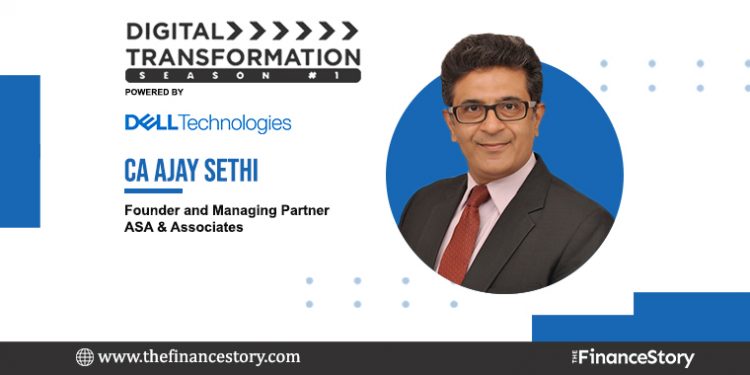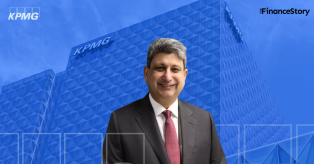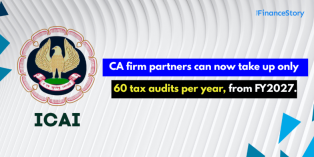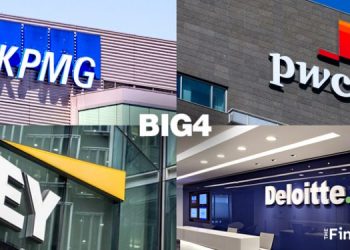- Meet Ajay Sethi, a Practicing Chartered Accountant and the Founder and Managing partner of ASA & Associates (ASA).
- ASA is one of India’s leading accounting and consulting firms dealing with clients from around the globe and has a team that has grown to over 700 professionals over the past 3 decades.
- As part of The Finance Story Digital Transformation series powered by Dell Technologies, we spoke to Ajay and his team about how ASA adapted to technology as an accounting firm.
As a managing partner of ASA, what is digital transformation for you?
This word, ‘Digital Transformation’ is a bit of a misnomer. When we went into computerization, nobody called it computerized transformation, or when we went into automation, nobody called it a transformation.
In simple words, Digital is the new method to upgrading working style and environment. A natural evolution to follow the earlier ones. However, given that the word “transformation” has caught on, one walks along.
For me, digital is all about enhancing efficiency and doing tasks at a lesser cost and time through data analytics, digital tools, etc.
ASA has been at the forefront with regard to digital transformation – What is your firm’s Digital Transformation journey?
My professional journey is all about partnering with the right people at the right time. This applies to our digital journey too.
Early on, around 7-8 years ago, we understood the importance of cybersecurity, customizing tally, and shifting internal functions to ERP software. All this was possible through self and good vendors.
The onset of AI and Machine Learning, made us realize the need for an expert in the years ahead. That’s when CA Manoj Dua was identified to guide our Digital team.
We truly went digital 4-5 years ago (around 2015) and have been systematically digitizing different aspects of our firm.
In the last 2-3 years, it moved into a need to not experiment but have a focused overall plan for the firm’s digitalization. Importantly, the plan should integrate various efforts into a common thread and not leave verticals loosely connected. That brought to existence our Digital strategy, a team, and a digital leader.
We see digitalization as two buckets – one Internal and the other Externally focused.
Internal, where we are rehashing or adopting new processes within the firm, moving to the cloud, and adding digital tools to enhance administrative and finance functions or those that add to client delivery.
Our External outlook is the revenue-generating focus. Using our own “going digital” experience and with a well-rounded tech team as enablers, we assist clients in adopting best digital practices viz. data analytics, digital adoption in specific functions, etc.
Each organization, even within the same industry, will have different needs and goals that echo the outlook of the top management. Thus when digitizing, it is critical to understand what is a must-do, what is not so important, and what is not to be done. This will help define a clear milestone-based implementation chart.
Tell us more about it.
We have 5 service verticals.
Initially, we did a small roundup with the leaders of each vertical to understand ‘where’ they wanted technology.
We then prepared a detailed roadmap of 3 years focusing on where we could digitalize in each vertical.
We dug down into the fundamentals to understand the impacts, cost, and a timeline of what needed to be done and by when.
We picked up critical areas in each of the verticals and took that to the concerned partners for ratification. A similar approach was taken for administration functions viz. HR, Finance, Training, etc. Then, we started implementation.
We searched for what could be purchased, what could be developed in-house, and where free solutions can be adapted and tweaked.
Once we identified a digitalization option for a service vertical, we took the product to the concerned “champion” of the vertical. They did detailed testing and efficiency checks. Once we have a positive response, the concerned “champion” from the vertical, our digital team, and the vendor start the integration process.
What were the key areas that ASA chose to focus on when your firm started its Digital Journey?
When we started our digital journey, it was about an ERP system to clock and measure time, accounting on the cloud, and HR issues viz. hiring, onboarding, etc., and all this was made available even via a smartphone to any key management person on a real-time basis.
As we developed a better focus, and the market forces moved in that direction too, we started looking at some basic products to enhance service capability viz. OCR, secretarial compliances, tax management tools, document management, audit planning, etc.
We initially focused on Customer Relationship Management, Tax litigation management, tax return compilation, International best practices for audit planning and documentation, deal tracking for M&A, etc. We further went into security, websites, and network structures that we had, and even dug into the basics like our existing antivirus system. Basically, we streamlined the existing base.
With a focus on direct revenue generation, we got into data analytics i.e. creating reporting structures out of the ERP or the CRM system to enable crisper information for decision-makers.
We also assist clients to move to the cloud or realign their cybersecurity environment in this more virtual world.
This was all included in Phase one.
In the next phase, there are varied products for each vertical that is being evaluated. These include upgrading Audit tools, project management software, etc. Some we had identified earlier went obsolete or have better variants. All that is being examined. The overall plan is to have a majority of our operations digitally transformed by 2023.
Before the pandemic hit, virtual meetings were a rarity. Once the pandemic hit, we moved entirely to virtual meetings. Our in-house and client seminars too had to move online. For this, we looked at optimizing the usage of existing software licenses and carefully calibrated options to find something that was best suited to our usage patterns and hardware available with our staff.
What is your role in the Digital decision-making process as a Managing Partner?
Any managing partner of my age — I am 56 today, who claims to understand Technology of the digital kind thoroughly, is wrong. It doesn’t come to us naturally. Regretfully, I fall within the norm. This is where my young and able colleague CA Manuj, who leads our digital initiative, comes in.
I am able to grasp the nuances through him and the team. They highlight the issue and provide me with facts and possible digital options. We also evaluate each to the needs of the firm.
While the technological backend is their forte, my skill lies in the ability to make quick decisions. But I do spend time understanding the issue, seeking answers through self-research, and deep-diving into options before me. If the facts support it, I simply approve, or else we re-evaluate.
In short, this teamwork is the secret of our successful digital initiatives.
Has your overall cost due to digital transformation gone up?
I don’t think so. Analyzing internally and deciding what we need has helped us.
Defining digital planning 2-3 years before actually jumping into it is important. Systematic planning is required in digital. Just because one has the money or desire, doesn’t mean one has to plug in everything.
Analyzing internally and deciding on what we need has worked well for us.
Everyone is talking about Cloud Support: what does cloud mean to your firm?
We run a hybrid system. We have hardware and also structures on the cloud. We are slowly moving our entire on-premise servers to cloud servers so that we eliminate the requirement of basic servers that are on-premises.
We feel that the optimization and the levels of comfort on a cloud structure are much better and were already using the cloud before the pandemic hit – our ERP and CRM packages were all on the cloud.
Once the pandemic hit, we continued to gradually move more of our data to the cloud.
How did your team decide on what cloud company to go for?
We look at what is available and mix and match, so we are not dependent on any one cloud provider. Today, nobody can, or should, depend on just one cloud structure.
Cybercrime is a major issue of late. Have you experienced any major hacking episodes and/or cybercrime incidences?
Cybersecurity is a very big problem nowadays and over the past years, the number of attacks has also increased multifold. This will continue in the future too.
When we moved to remote working, we had to allow people to connect to our servers remotely. Firstly, we did a complete network check of our own servers, including the cloud servers and websites. We found a few gaps and plugged them.
Now, every three months we do a detailed audit of the networks and monitor for newer threats that come along. This level of monitoring was useful when one of our cloud servers on which we were running several key applications was hit by a DDoS attack.
Fortunately, we took preemptive action and were able to push that back in about 30 minutes with zero downtime. We haven’t yet had any incidents like data leakages or linkbacks.
Nowadays with everyone talking about digital, has clients’ perspectives towards auditing and accounting firms shifted as well?
Clients are already asking about digital adaptation and in what areas we have adapted to technology. Remember, in today’s world of classifying everything, we are viewed as vendors. Amongst other factors, they will bench your digital preparedness vis a vis others in the fray before making a decision.
The other question we get is, “what are the digital changes that you can help us bring in?” be it through our own products or those we identify from outside vendors. And it does normally lead to our data analytic capabilities.
On the face of it, data analytics looks like a basic thing. But the nature of data under your scrutiny and how it is to be represented is the real deal. That’s where one’s knowledge, ability to gauge unknown expectations, and sense of aesthetics come into play.
For example, every ERP throws up balance sheets, trial balances, expenses, etc. But a CEO needs specific aspects of that plus non-accounting information, e.g. sales or inventory, to keep a close watch on his company and take critical decisions. Knowing what the right information is and how to comprehensively present it through a dashboard will define future success. Customization is where the opportunity lies.
Closing message…
As you can see, our digital transformation was an inside-out exercise. Because of the intense level of research and investigation, we ended up with products and solutions that are customized to our needs and cost-effective.
Remember, people’s buy-in is the critical part. Therefore, include the people who would be using the tool, be sure that they are comfortable with the tool, and consider the amount of time they would spend on the tool.
A word of caution here – Professional services are highly influenced by rapidly changing regulations. Technology companies usually build products for more mass-market organizations with simpler ecosystems, like FMCG, manufacturing, or banking.
There aren’t many technology solutions in the market for professional services firms and often what is available may not meet your requirements. Therefore, one must carefully identify the needs of their team and their firm and only then begin to look for solutions in the market.
If I may be bold and suggest that for any managing partner, unless a self-expert, having a technology expert is the first key element. Let the expert deep dive into the technology end. You should play with that information and bring to bear management experience to evaluate the commercial possibilities and adoption capability of the firm.
Importantly, a managing partner should remain closely involved with the digital transformation. That is the only way teams across will take the entire digitalization exercise seriously.
Now It’s Your Turn…..
Comment below and let us know what are your thoughts on Digital Transformation and Technology.














